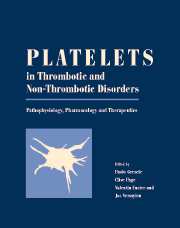Editors' preface
Published online by Cambridge University Press: 10 May 2010
Summary
Blood platelets have attracted an increasing interest among clinicians and basic scientists over the last three decades due to the progressive understanding of the role that these cells play in different physiological phenomena and pathological conditions. Indeed, blood platelets not only participate in normal hemostatis and are a central element in atherothrombosis but are also involved in inflammatory and allergic reactions, in some forms of gastroenterological, renal and dermatological disorders, in tumour metastasis and in viral, bacterial and parasitic diseases. It is impressive to realize that blood platelets play a primary role, or are involved, in the diseases responsible for the large majority of disability and death worldwide, and namely not only in myocardial infarction, stroke or peripheral vascular disease but also in cancer and its dissemination and several types of infection. Moreover, platelets, due to their easy sampling and to the fact that they possess a rather complex and complete signal transduction machinery typical of excitable cells, are often taken as a model for neurochemical, biochemical and molecular biology studies. It is also important to underline that, based on the expanding knowledge of platelet biology and pharmacology, recent developments in the field of antiplatelet agents have led to relevant therapeutic advancements with great excitement among cardiologists, neurologists, angiologists and internists.
- Type
- Chapter
- Information
- Platelets in Thrombotic and Non-Thrombotic DisordersPathophysiology, Pharmacology and Therapeutics, pp. xxi - xxiiPublisher: Cambridge University PressPrint publication year: 2002



